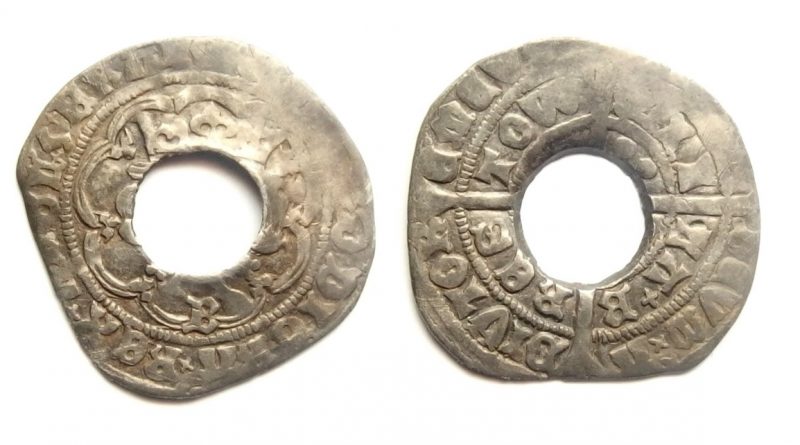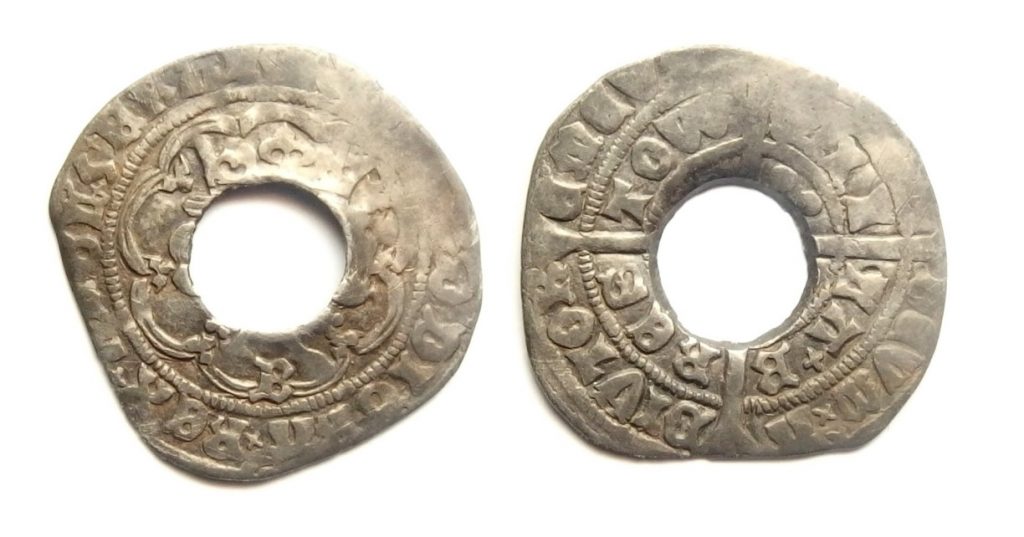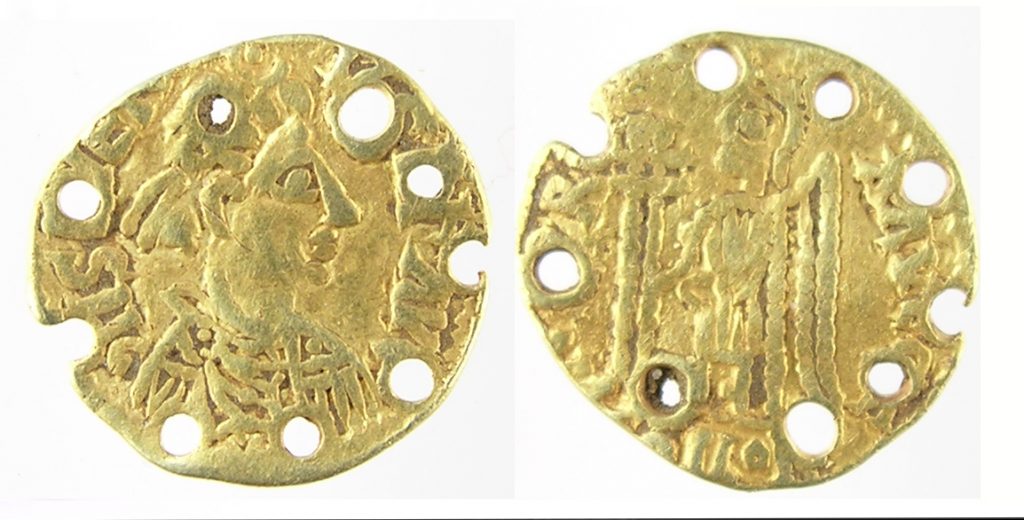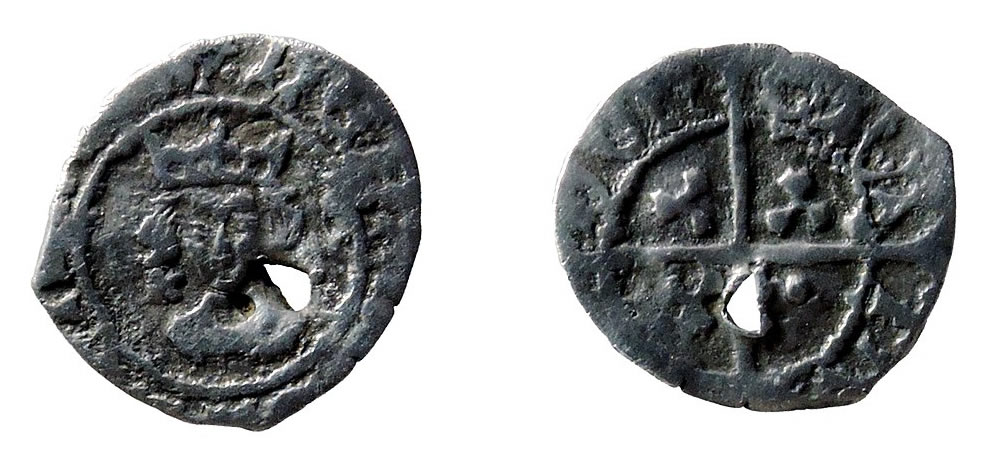Mystery of Groat with a large hole in the centre
Mystery of Groat with a hole
This very unusual find came in from John Caluori, who said it is presently with a coroner. It’s an Edward IV groat of Bristol, which has had a very large hole punched through the centre. Apart from the hole, this is a standard Edward IV groat with no other alterations or additions.
Holes in coins for jewellery
It has now become standard practice for pierced coins to be reported as Treasure, as it is thought that the piercing was done so a coin could be worn as jewellery. In some cases this would be correct. For example, some pierced Roman coins are found in Anglo-Saxon burial contexts, which suggests they could have been worn as jewellery. The same could be said of some later medieval gold and silver coin.
Example of a coin pierced for jewellery: Roman coin with Early Medieval perforated holes.
Photo by The Portable Antiquities Scheme/ The Trustees of the British Museum, CC BY-SA 2.0
In my opinion a coin should not have to go through the Treasure procedure simply because it has a hole in it. The only time a coin should do is if it dates from a period when coins were converted into jewellery (the Anglo-Saxon period, for instance), or if there are additional signs (besides a hole) that it was made into a piece of jewellery.
Holes in coins for storage
However, from the Tudor period onwards it is not unusual for small hammered coins to be found with holes in them; these are often crudely punched and still have the burr around the holes. Had these coins been used as cheap jewellery then at the very least the holes would have been tidied up.
A more logical reason for the holes is that they were made in order to store coins on a piece of string. The vast majority of the pierced Tudor and Stuart coins that turn up are very small in size. Most ordinary folk didn’t have a pocket to their name and even those who had them would have difficulty in locating tiny coins if they were in a bottom corner. Therefore, an ideal way on keeping coins safe would be to store them on a piece of string. By not removing the burr around a hole no weight would be lost, so a coin would pass for its full face value.
Brooch without a pin
Example of a brooch made from a coin, this one with a pin.
A silver annular brooch made from a short cross penny of John or Henry III.
Photo by The Portable Antiquities Scheme/ The Trustees of the British Museum, CC BY-SA 2.0
John’s find pre-dates the Tudor period and the hole in the centre is very large – so large that the coin would not pass for four pence. I’ve seen a couple of late medieval silver coins that had been converted into ring brooches but most of the centre had been taken away and part of the edge reduced to accommodate the end of the fastening pin. Therefore, John’s find could not be described as a brooch without a pin.
Supporter's token theory
A search of the internet revealed only one other coin (Coin 2) where the centre had been punched out in such a manner. Coin 2 can be seen at www.historyincoins.com
This too was a Edward IV coin – a silver groat. The owner of that coin postulated that the bust was removed in order to be adorned on some sort of supporter’s device, such as a badge or a ring. The outside would therefore be scrap.
The part of this theory that suggests that the outside was scrap has some merit it has become distorted in the process, particularly so in Coin 2.
However, if the idea was to extract the bust of the Edward IV then you would expect that the tool to punch out the metal would have been placed on the bust so as to be able to align it more accurately. In both cases, the Kings head was punched out from the other side of the coin. Furthermore, Coin 2 would appear to have been struck more than once to remove the bust, which would suggest a lack of care for the removed piece.
Defacing the coin theory
Another explanation could be that the coin was deliberately defaced – Edward IV head is being symbolically removed from the crown. This was a turbulent time in history which may have lead to this grand gesture, which effectively cost a groat, as the coin is rendered effectively worthless.
That I can find only one other example like this and that too is an Edward IV coin adds weight to this theory.
It would be expected that if this practice did occur the two parts of the coin would probably be melted down afterwards. This would account for the lack of reported finds by detectorists. However, the lack of reported finds may also be because detectorists would consider a coin of this nature of little value and so not report it.
Mystery
All in all, this is a bit of a mystery. However, if you have any comments on the above or any other plausible ideas as to why this groat has a large hole in the centre then do let me know.
Also, I would be interested to hear if you or a friend has found a similar piece.
Valuation
If the groat had been intact it would have been worth around £150.
As it is, with the hole punched out, it’s worth about £20 – 30
Free Coin Valuation
If you have a coin that you would like valued, please see my free coin valuation service





